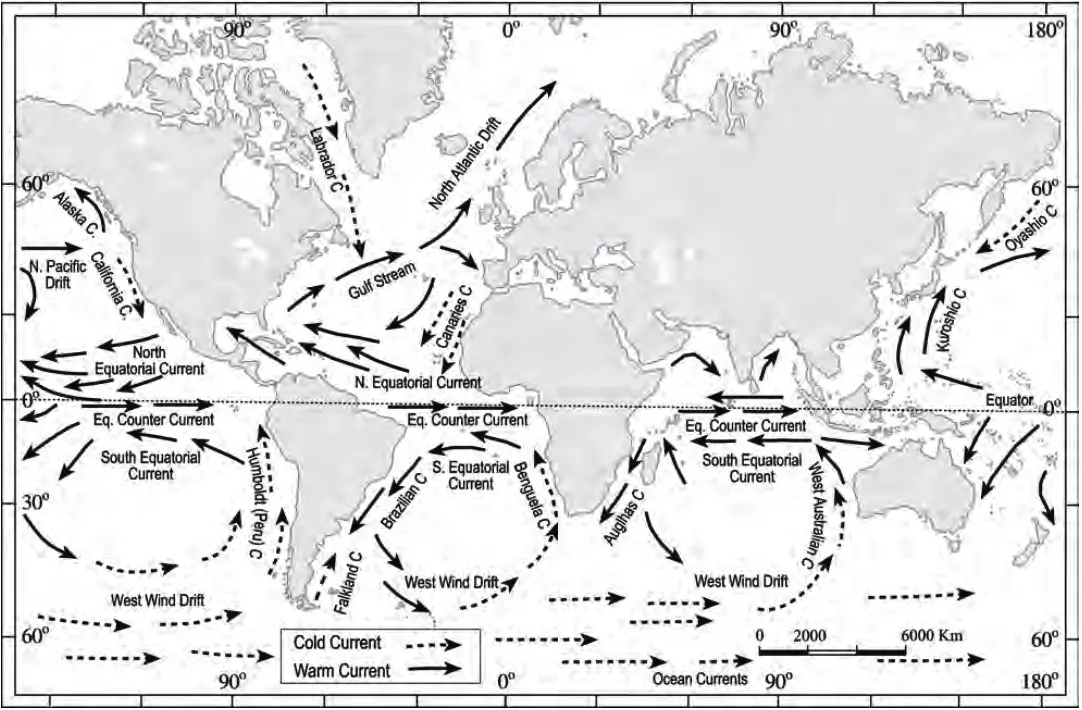NCERT Solution for Class 1 1 Geography Chapter 13 Movements of Ocean Water
Question.1. Multiple choice questions.
(i) Upward and downward movement of ocean water is known as the:
(a) tide
(b) current
(c) wave
(d) none of these
Answer
(a) tide
(ii) Spring tides are caused:
(a) As result of the moon and the sun pulling the earth gravitationally in the same direction.
(b) As result of the moon and the sun pulling the earth gravitationally in the opposite direction.
(c) Indention in the coast line.
(d) None of the above.
Answer
(a) As result of the moon and the sun pulling the earth gravitationally in the same direction.
(iii) The distance between the earth and the moon is minimum when the moon is in:
(a) Aphelion
(b) Perigee
(c) Perihelion
(d) Apogee
Answer
(b) Perigee
(iv) The earth reaches its perihelion in:
(a) October
(b) July
(c) September
(d) January
Answer
(d) January
Question.2. Answer the following questions in about 30 words.
(i) What are waves?
Answer. Waves are the energy, which moves across the ocean surface. Only water particles move in a little circle when a wave passes; water itself does not move in waves. Wind fuels waves with energy, causing them to travel in the ocean and release that energy on shorelines.
(ii) Where do waves in the ocean get their energy from?
Answer. Winds provide energy to ocean waves. Ocean waves are pushed by wind, and the energy is released on shorelines. The sluggish deep bottom water of the seas is very rarely impacted by the movements of the surface water. Waves continue to enlarge as they travel and take in wind energy.
(iii) What are tides?
Answer. The periodical rise and fall of the sea level, once or twice a day, mainly due to the attraction of the sun and the moon are called tides. The frequency, direction, and movement of tides vary from place to place and occasionally.
(iv) How are tides caused?
Answer. The main drivers of tides are, to a large degree, the gravitational pull of the moon and, to a lesser extent, the gravitational pull of the sun. The force that works to balance gravity is known as centrifugal force, which is another factor. The two main tidal bulges on earth are caused by the earth’s gravitational pull and centrifugal force.
Question.3. Answer the following questions in about 150 words.
(i) How do currents affect the temperature? How does it affect the temperature of coastal areas in the N. W. Europe?
Answer. Ocean current is maintaining the temperature balance of ocean water as the warm currents transport warm waters of the tropical zones to the colder areas of the temperate and polar zones. Cold currents bring cold water of high latitudes to the areas of low latitude. Thus ocean currents help in bringing homogeneity in the distribution of temperature of ocean water and thus help in maintaining the horizontal heat balance of low latitudes. The origin of ideal and favourable European type of climate of the western coasts of Europe is due to the effect of the north Atlantic warm current which is the extension of the Gulf Stream. The temperature of the coastal countries (e.g. the Great Britain, Norway, Sweden, Denmark, Netherlands etc.) are the higher than the average temperature for their respective latitudes.
(ii) What are the causes of currents?
Answer. The primary forces that influence the currents are:
- Heating by solar energy: Heating by solar energy causes the water to expand. The ocean water near equator is about 8 cm higher in level than that in the middle latitudes. This causes a very slight gradient and water tends to flow down the slope.
- Wind: Wind blowing on the surface of the ocean pushes the water to move. Friction between the wind and the water surface affects the movement of the water body in its course.
- Gravity: Gravity tends to pull the water down to pile and create gradient variation.
- Coriolis force: The Coriolis force intervenes and causes the water to move to the right in the northern hemisphere and to the left in the southern hemisphere. These large accumulations of water and the flow around them are called Gyres. These produce large circular currents in all the ocean basins.
(iii) Visit a lake or a pond and observe the movement of waves. Throw a stone and notice how waves are generated. Draw the diagram of a wave and measure its length, distance and amplitude and record them in your note.
Answer. Attempt yourself.
(iv) Take a globe and a map showing the currents of the oceans. Discuss why certain currents are warm or cold and why they deflect in certain places and examine the reasons.
Answer. 


